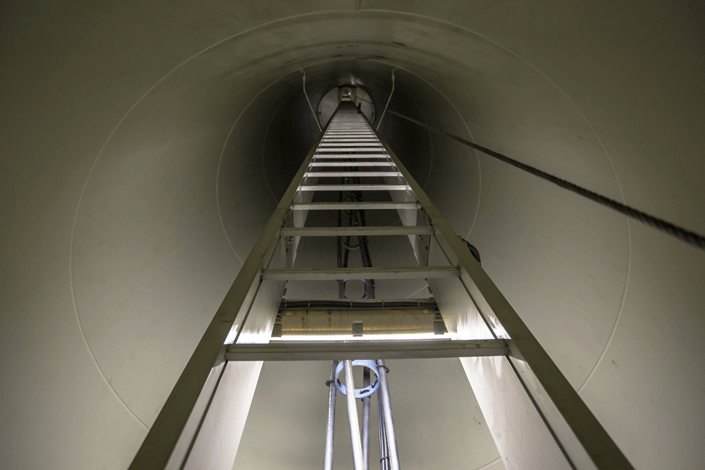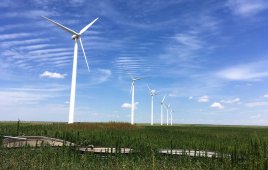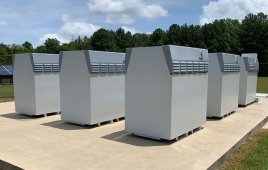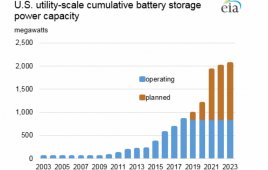Editor’s note: This article comes from MaxPower Weekly, a blog from Maxwell Technologies. It is authored by Ralph Heick, Key Account Manager, EMEA.
Wind turbines are strong, durable machines, but they are susceptible to damage by the wind they manage to harness into energy.
To help protect the wind turbine from damage during excessive wind speeds or during a grid power loss, wind turbines are built with emergency pitch control systems. The pitch system is responsible for shifting the turbine’s blades out of the wind and thereby slowing down the rotor to stop the turbine from spinning out of control.

Wind technicians must go through a very involved process to climb wind turbines and replace end-of-life or failed battery parts for emergency pitch backup systems. Ultracapacitor energy storage helps reduce maintenance hours. (Photo: Maxwell Technologies)
The pitch system has no room for failure. It is an absolutely critical part of the wind turbine. Even when there is a redundancy system, wind farm operators want to be assured that the system will pitch all three blades successfully when necessary, since damaged turbines equate to millions of dollars in lost assets.
The vital part to the successful operation of the pitch system is the system’s energy storage backup power, which is served by two different storage technologies for electric systems: ultracapacitors (also called supercapacitors or electric double-layer capacitors) and lead-acid batteries.
Batteries or ultracapacitors for power delivery
Both ultracapacitors and lead-acid batteries are used as backup energy storage for the wind pitch application. Both technologies provide the necessary power to rotate the blades during an emergency shut-down situation.
In Europe, wind farms trend toward ultracapacitor-based backup energy storage for pitch control due to the technology’s several advantages over lead-acid batteries for this application, including significantly longer life, reliable performance in very hot and cold climate conditions, and minimal maintenance needs compared to batteries, whose lead-acid chemistry is vulnerable to varying ambient temperature conditions.
Reliance on lead-acid batteries for the pitch system application often leads to several replacements of the batteries over the lifetime of the turbine, which in turn increases component replacement costs and the costs of downtime. Technicians must go through a very involved process to climb the turbines and replace end-of-life or failed battery system parts.
I’ve had several discussions with technicians at wind industry conferences where they relate similar stories. When one battery system fails, the technicians often choose to replace the battery systems for all three blades in one climb, since the batteries age at approximately the same rate and it’s common for the other systems to fail within weeks of the initial failure. This is especially relevant in the hotter geographic areas of Europe.
The original battery systems show a pattern of not fulfilling the pitch system function as reliably as desired in the industry. There are turbines with oversized battery systems that do perform well for five-plus years, but these systems tend to be complex and still have maintenance requirements. Newer turbines are aging more slowly and have an expected lifetime of 25 years. Wind farms need energy storage that provides much longer lifetime if they want to avoid exchanging the main components at five-year intervals.
Ensuring a solid pitch
Wind turbines operating with ultracapacitor-based energy storage for the pitch systems typically require minimal maintenance due to the ultracapacitors’ rugged performance capability in the demanding and remote turbine environment.
Ultracapacitors are electrostatic devices that do not contain lead or acid, making the technology much more durable in the face of hot or cold weather conditions, thus prolonging the lifetime of the energy storage system to closer match the lifetime of the turbine itself. The average lifetime for ultracapacitor energy storage is 10 or more yearsdependent on use, and has enabled wind farms, both onshore and offshore, to reduce their O&M costs and experience more revenue-generating hours.
In addition, the speed with which ultracapacitors can discharge power and recharge is a significant advantage for the wind pitch control application. In most wind turbines, the pitch system is not used on a daily basis, only during unforeseen emergency shut-down situations and during monthly routine pitch tests. Ultracapacitors can withstand extended periods of non-use and provide reliable, fast-reacting power when needed. Batteries can present operational issues after extended periods of idle time, which in turn can affect their ability to provide burst power ina moment’s notice.
About 20 years ago, the first designs for electrical pitch control systems emerged in Europe. The wind industry was forged in Europe and so was the technology behind the pitch system. The influencers who invented pitch control technology continue to develop advanced versions of the system and deliver the technology to wind turbine manufacturers worldwide. The market for pitch control systems with ultracapacitor backup energy storage is quite mature.
Wind farms continue to trend toward ultracapacitor energy storage for the emergency pitch control application due to the variety of benefits outlined above. It’s encouraging to see the European wind market embrace technologies that help support greater efficiency and day-to-day operations.
To learn more about ultracapacitors for wind pitch control, watch the video: What you need to know about ultracapacitors for wind turbines.
Filed Under: Energy storage, News, Sensors




